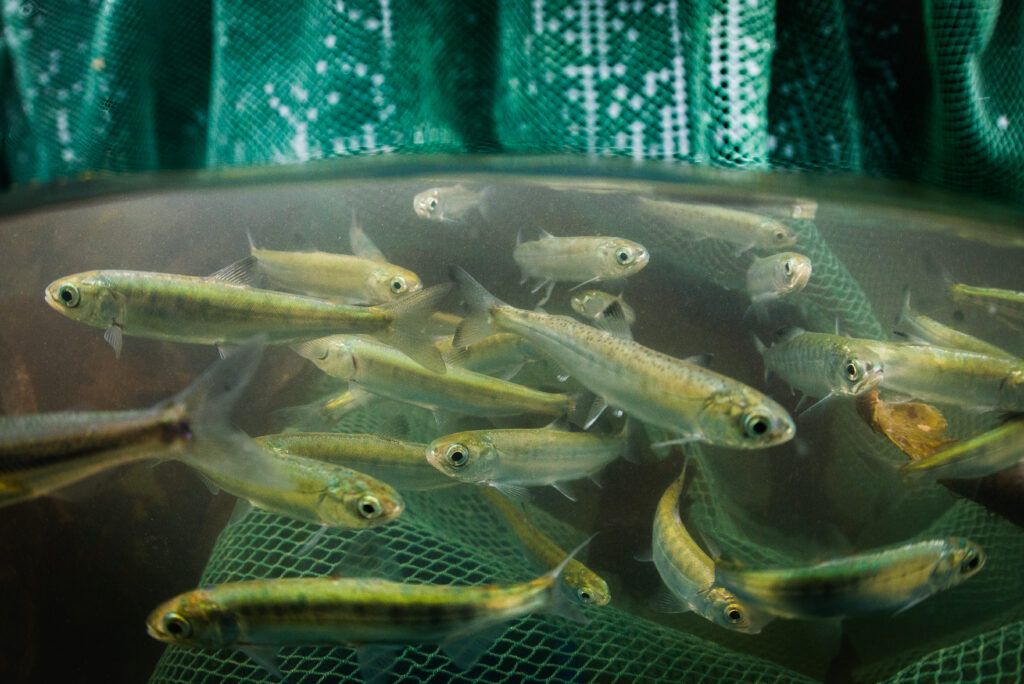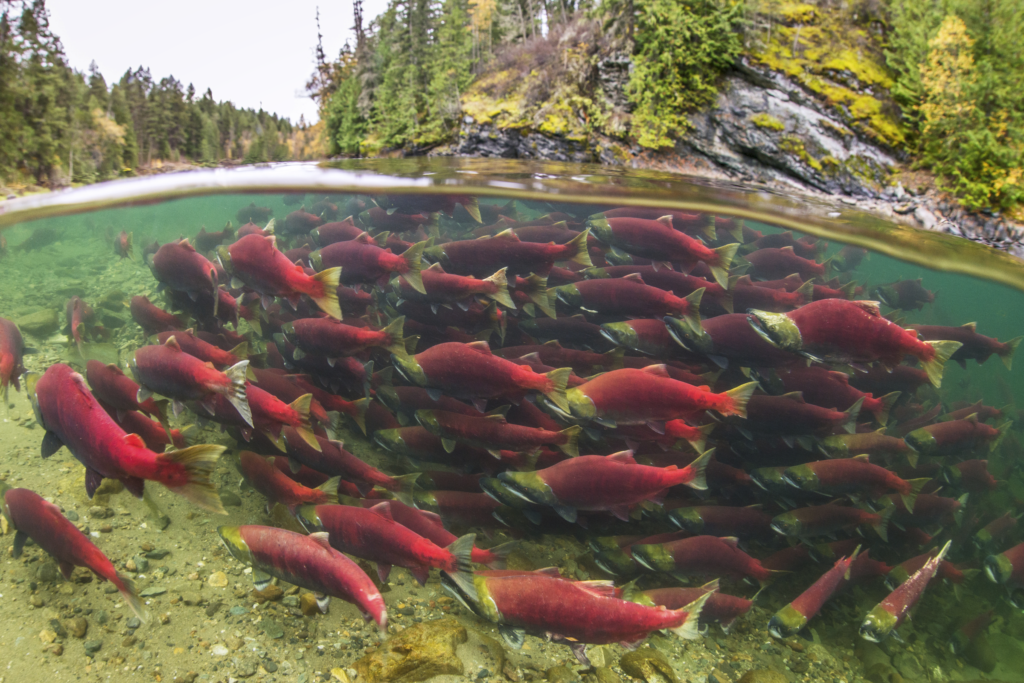‘They never said a word’: DFO told B.C. salmon farmers, but not First Nations, about mouth rot infestation | The Narwhal
Federal government scientists are sounding the alarm about a mouth rot disease that has infested Atlantic salmon farms in B.C., saying there are “realistic and serious” concerns about transmission of the bacteria that causes the ailment to migrating Fraser River sockeye salmon.
But while Fisheries and Oceans Canada (DFO) managers briefed the salmon farming industry last fall, neither the public nor First Nations engaged in salmon farming consultations were informed about the prevalence and potential dangers of the bacterium Tenacibaculum maritimum, which produces yellow lesions in Atlantic salmon.
New title

Get The Narwhal in your inbox!
People always tell us they love our newsletter. Find out yourself with a weekly dose of our ad‑free, independent journalism
“The fact that they knowingly withheld this information from First Nations consultations is absolutely appalling,” Bob Chamberlin, chair of the First Nations Wild Salmon Alliance and a member of the Kwikwasutinuxw Haxwa’mis First Nation, told The Narwhal.
Details about the bacterium — found in significant concentrations in the water column around active Discovery Islands salmon farms on the east coast of Vancouver Island — are contained in the response to a federal access to information request obtained by the non-profit group Watershed Watch Salmon Society. The response shows that federal scientists also expressed concern about the risk of population level impacts to wild chinook, coho and sockeye salmon.
Mouth rot, which is affecting Atlantic salmon in farms all over the B.C. coast, presents with lesions on the upper and lower jaws, making it difficult for fish to feed. Mortality rates can reach 30 per cent, according to DFO. Once established, the disease can re-occur in populations over several months. Treatments such as sulpha antibiotics “have been found to be useful” in controlling the disease, DFO says, noting that multiple treatments are often required.
Chamberlin said DFO knew about the potential risks Tenacibaculum maritimum posed to wild salmon at the end of September and subsequently engaged with B.C.’s salmon farming industry.
From October to December, First Nations were involved in consultations with the federal government, setting the stage for Ottawa’s decision to phase out open-net pen salmon farms in the Discovery Islands by June 2022.
“And they never said a word,” said Chamberlin, who took part in the consultations.
“What’s coming out now about the department’s behaviour in DFO Pacific should be of concern to all British Columbians and Canadians at large. This is a federal department meaningfully and intentionally undermining consultation with First Nations.”
 A fish farm in the Discovery Islands on the coast of B.C. where federal scientists documented an infestation of a bacteria that causes mouth rot in Atlantic farmed salmon. Photo: Tavish Campbell
A fish farm in the Discovery Islands on the coast of B.C. where federal scientists documented an infestation of a bacteria that causes mouth rot in Atlantic farmed salmon. Photo: Tavish CampbellBacteria concentrated around fish farms, creating risk for wild salmon: scientist
Stan Proboszcz, science and campaign advisor for the Watershed Watch Salmon Society, said revelations about the Tenacibaculum maritimum bacterium should convince the federal government to advance its 2025 deadline for ending open-net pen salmon farming in B.C.
“We have parasites, sea lice. We now have a bacterium that is impacting wild fish. And we already know there is a virus called piscine orthoreovirus, or PRV,” Proboszcz said in an interview. “It’s like this perfect storm of pathogens emanating from these farms and impacting B.C.’s wild salmon.”
PRV is a disease found in 80 per cent of farmed Atlantic salmon that is linked to a host of fish health problems, including heart and skeletal muscle inflammation and haemorrhages in internal organs. It gained notoriety after a video of bloody discharge from packing plants in Tofino and Campbell River went viral in December 2017.
Federal fisheries scientist Kristi Miller-Saunders recently told the Standing Committee on Fisheries and Oceans that the highest incidence of infection with the bacterium that causes mouth rot in Atlantic salmon was found in fish migrating past Discovery Island salmon farms.
“We were also able to show that in the water column Tenacibaculum maritimum was one of the agents most strongly concentrated around active farms, compared to fallow farms,” Miller-Saunders told the committee. “So there was a lot of Tenacibaculum maritimum in the water column.”
Miller-Saunders said DFO examined whether or not treatment of mouth rot in salmon farms was a correlated factor with potential transmission into wild fish.
“We did not find that there was any effective treatment,” she told the committee. “Simply a farm being stocked with fish was enough to create a risk to wild migrating salmon.”
 Salmon smolts in a B.C. open net pen salmon farm. Photo: Tavish Campbell
Salmon smolts in a B.C. open net pen salmon farm. Photo: Tavish CampbellQuestions raised about DFO role in managing both farmed and wild salmon stocks
In the documents obtained by Watershed Watch, Carmel Lowe, DFO’s regional director of science, noted that infection with the bacterium in wild chinook, coho and juvenile sockeye salmon is “associated with poor body condition and potentially indicative of poor health outcomes and subsequent returns.”
Allison Webb, director of DFO’s aquaculture management division, said DFO models raise “realistic and serious concerns about farm-origin transmission of Tenacibaculum maritimum to Fraser River sockeye salmon and population level impacts to chinook, coho and sockeye.”
“As with any statistical findings, there remains uncertainty in our model results, but it is the bulk of evidence, rather than any one particular model, that should give pause,” Webb wrote in an email, included in the documents.
“Taken together, results from wild-salmon screening … highlight Tenacibaculum maritimum as one of the most likely candidates for population-level impacts on wild populations, and present evidence that infections in Fraser River sockeye may originate from salmon-farm sources, especially in the Discovery Island regions.”
“Given knowledge about the depressed state of Fraser River sockeye stocks, the evidence we have presented suggests extreme caution and further research are required,” she said.
In a Dec. 16 email, DFO regional director general Rebecca Reid wondered if the deputy minister wanted more information about Tenacibaculum maritimum, noting that “nobody likes surprises.”
But when Gord Johns, federal NDP fisheries critic (Courtenay-Alberni), asked during an April standing committee meeting if Fisheries Minister Bernadette Jordan had been briefed, he didn’t receive a straight answer either from Reid or a second DFO employee.
“It begs the question if the office of the minister knew and they were in consultations with First Nations around the Discovery Islands, then why did they hold back the information?” Johns said in an interview.
“That’s pretty disturbing. How are they supposed to build trust? And how are Indigenous people supposed to trust government? When we talk about reconciliation and meaningful relationships, you don’t hold back information …”
In response to questions, the BC Salmon Farmers Association said in an email that mouth rot is caused by the marine bacteria Tenacibaculum maritimum “that naturally occurs in the Pacific Ocean and is common around the world.”
“Our fish enter the ocean environment vaccinated and healthy, but as the bacteria exists in the ocean waters, they can become exposed once in the marine environment,” the association said.
It said farmed fish receive regular health checks, up to several times a day. “If during these inspections symptoms of the bacteria is detected, immediate treatment with infeed antibiotics is administered by a veterinarian, as vaccine trials in this area are ongoing,” the association said, adding that natural immunity to the bacteria is typically achieved about four to six months after fish enter the marine environment.
“This bacteria has been extensively studied, and initial research indicates that wild Pacific salmon are not affected by the bacteria, and we have not seen reported cases of mouth rot on wild Pacific salmon.”
Calling DFO’s information about Tenacibaculum maritimum “alarming and deeply disturbing,” Johns said it points to the pressing need for the federal government to follow through on a 2015 election promise and remove responsibility for aquaculture industry promotion from DFO, as recommended by the Cohen Commission report, the result of a three-year inquiry into the 2009 collapse of the Fraser River sockeye salmon fishery.
“DFO’s role should be to protect wild salmon,” Johns said. That should be their sole responsibility.”
Chamberlin also said the decision to withhold the information about Tenacibaculum maritimum from First Nations highlights the inherent conflict of interest in DFO’s dual role.
“It clouds their judgement for their primary responsibility of looking after the wild salmon and their environment.”
 Wild sockeye salmon. Photo: Tavish Campbell
Wild sockeye salmon. Photo: Tavish CampbellAfter the federal government announced its decision to close all 19 Discovery Island salmon farms by June 2022, salmon farming giant Cermaq sought a judicial review, arguing the process was unfair and the decision, supported by seven local First Nations, needed to be revisited.
Cermaq also filed written arguments and evidence to support an injunction application by Mowi Canada West (formerly Marine Harvest) and a numbered company that sought to transfer hundreds of thousands of fish to Discovery Island farms this year, despite a federal decision prohibiting the farms from being restocked.
In April, a federal court judge suspended the ban on restocking three fish farms, saying the two companies would suffer real and irreparable harm if they weren’t allowed to restock farms.
Johns said the fisheries minister should declare a wild salmon emergency in B.C. given that the province has just seen two of the lowest returns in recorded history in the Fraser River, the largest sockeye salmon bearing river in the world.
“We’re seeing river systems from Kitimat to the west coast of Vancouver Island that are collapsing.”
By accepting you will be accessing a service provided by a third-party external to https://oc3anclub.com/

